Lunar Gardening and its Different Traditions
Since time immemorial, people are using the cycles of the Moon as a guidance in their household activities. This is not a superstition: even contemporary mechanistically minded science has a significant amount of research showing that the lower forms of life (such as plants, for example) are strongly, intimately albeit invisibly connected to the rhythms of the Moon, that they are synchronising their life activities with the Moon.
Unfortunately, our science is madly prejudiced against everything that even remotely resembles astrology. As a result, we don't have any reliable, scientifically tested and verified set of rules that would allow us to use the knowledge of the Moon's cycles in gardening with confidence.
Instead, we have the tradition, and not just one but at least too different traditions of lunar gardening. I tend to call these two traditions the American and the European, although I admit that this naming might not be 100% precise as apparently researchers from both sides of the Atlantic have made their input into both traditions.
Both traditions have a significant number of followers, both have a number of documented experiments supporting their rules, but the rules are quite different and in certain cases contradicting each other. So I suggest you make a clear choice, which tradition you are going to follow, and then stick to it.
The American Tradition of the Lunar Gardening
The rules of the American tradition are listed in many books, and they are quite simple. One good source of these rules is the Llewellyn's Moon Sign Book. In the end of this article I will give you links to the books that I could recommend. I am not going to list all the rules and nuances, please refer for those to the books, but the main rules are:
- If you want to get the result above the earth, use the waxing (growing) Moon. According to this rule, you would plant your flowers, strawberries, tomatoes etc. when the Moon is increasing in light, i.e. after the New Moon but before the Full Moon.
- If you want to get the result under the earth, use the waning (decreasing in light) Moon. So if you are going to plant potatoes or carrots then according to this tradition you are supposed to do that after the Full Moon but before the New Moon.
- There are fruitful signs (Taurus, Cancer, Libra, Scorpio, Capricorn, Pisces) when you are supposed to do everything that promotes growth. The Moon spends about two and a half days in each sign, and you need to use a lunar calendar, like the Universal Lunar Calendar, to find out when she is in one or another sign in your particular time zone.
- There are also barren signs: Aries, Gemini, Leo, Virgo, Sagittarius, Aquarius. When the Moon is there, you should do things that prevent growth, like pruning, cutting etc.
- The important bit of information is that the American tradition uses the tropical zodiac. This is the zodiac that is very widely, almost exclusively, used in the Western Astrology. For example, when saying that Aries people are born from the 20th of March to the 19th of April, you are implicitly referring to the tropical zodiac.
If you prefer to follow the American Tradition, then everything you need for your lunar gardening is the Universal Lunar Calendar. It gives the dates and the times of the lunar phases as well as the the dates and the times of the Moon's entry into each of the signs of the tropical zodiac for virtually any location on the Earth.
Here are some examples that will help you to find out what means what, but basically just check the symbol explanations underneath the calendar, and you should be able to figure out everything yourself.
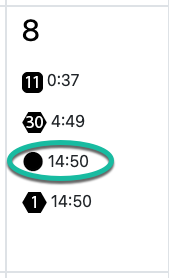
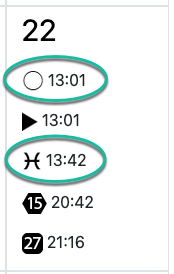
The European Tradition of the Lunar Gardening
The European tradition, as far as I know it, is associated with the name of Rudolph Steiner.
The fundamental difference of this tradition, in its original form, is that it doesn't use the tropical zodiac, and not even the sidereal zodiac. Instead, it uses constellations, i.e. more or less arbitrarily defined groups of stars on the celestial sphere. The problem here is that if we want to follow Steiner strictly, then we need to know the borders between constellations as they were defined at his times, in the beginning of the 20th century.
Constellations and Zodiacs
For an explanation of the difference between the signs and the constellations, as well as between tropical and sidereal zodiacs, you might want to read Lesson 3, The Zodiac, of the Lunarium Lessons.
I have spent a lot of time trying to figure out where those borders between constellations should be, so that we could know in which exactly constellation the Moon is in at any specific moment, I have asked several authorities and then a number of different people who might have known the answer, but nobody was able to give me any information on this subject.
Finally, in The Biodynamic Sowing And Planting Calendar by Maria and Matthias Thun, I was able to find the information about the hour when the Moon enters each of the constellations during the year 2010. Taking the average of the Moon's position for different months, I should be able to figure out a reasonably precise information for where the borders between the constellations are. And later, if I will find a more detailed source of information, I could make the numbers more precise.
However, one of the prominent astrological researchers Nick Kollerstrom (referred to as the BBC's Lunar Gardening Correspondent) argues in his book Gardening And Planting By The Moon that because the constellations are irregular, their use creates an imbalance in the energies available to the gardeners. Here is a quotation from the aforementioned book:
The trouble began when Maria Thun imposed the four elements on to this irregular set-up in the 1950s. Her use of these divisions made for a radical imbalance in the four elements. Root days (Earth) were assigned over 50 per cent more of the month than the Flower days (Air). The Air-constellation Libra is very short while the Earth-constellation Virgo is two and a half times longer.
Nick Kollerstrom suggests that instead of constellations, we should rather use the sidereal zodiac. The difference between the constellations and the sidereal zodiac is that the latter is made of equally sized, 30 degrees of longitude each, signs of the zodiac.
The difference between the tropical zodiac (used in the American method) and the sidereal zodiac (advocated by Kollerstrom) is that they have different point of origin, and as a result they are shifted against each other.
The difference is approximately 24°, and because of this difference, it can easily happen that according to the tropical zodiac, the Moon is in one sign (say Aries), while according to the sidereal zodiac, it is in a completely different sign, say Pisces. This is why the times of the Moon's entry into the signs are different between the Lunar Gardening Calendar and the Universal Lunar Calendar (I am often asked about this difference by the visitors of Lunarium).
In the previous paragraph, I referred to the Lunar Gardening Calendar. It used to be a part of Lunarium, but because of some breaking changes in the underlying platform it doesn't work anymore. In the new version of Lunarium, I haven't created such a calendar yet, so the screenshots below will be showing the old Lunar Gardening Calendar which at the moment of this writing wasn't re-created in the new Lunarium yet. If you believe such a calendar would be important for you, please tell me that by emailing to master@lunarium.co.uk, and I'll increase the priority of its re-creation.
The version of the Lunar Gardening Calendar I created so far is based on the sidereal zodiac. In a later version, I am planning to add as an option the possibility to switch to Steiner's constellations.
Root, Leaf, Flower and Seed Signs
Another major difference is that according to the European system, the most important factor is in which sign (constellation) the Moon is in, not the phase of the Moon like in the American system. Phases are actually aren't that significant in the European tradition.
There are four groups of signs (constellations): Seed Signs (Aries, Leo, Sagittarius — the Fire signs of the Traditional Astrology), Flower Signs (Gemini, Libra, Aquarius — the Air signs of the Traditional Astrology), Leaf Signs (Cancer, Scorpio, Pisces — the Water signs of the Traditional Astrology) and Root Signs (Taurus, Virgo, Capricorn — the Earth signs of the Traditional Astrology).
As you might expect, according to the European Tradition, when the Moon is in one of the Seed Signs, the energy in the plant is mainly concentrated in the fruits and seeds, these parts develop more actively and so this time is most appropriate for cultivating those plants that are grown for their fruits and seeds (e.g. apples, tomatoes, beans, cereals).
The Flower Signs, when the Moon is in one of them, activate the growth of flowers. These days are recommended for cultivating those plants whose fruits are, from the botanical point of view, flowers, like artichokes or cauliflower. Of course, they are good for the real flowers too.
The Leaf Signs, when the Moon is in one of them, promote the growth of the leaf parts of plants. These periods of time are the best for cultivating plants like cabbage, salad or spinach.
The Root Signs, when the Moon is in one of them, mark the time when the bark and the underground parts of the plant develop well. This is an appropriate time for cultivating potatoes, carrots, onions and other similar plants.
Waxing Or Waning Moon
It seems that the authors of the lunar gardening guides that follow the European Tradition do not pay much attention to whether the Moon is waxing (increasing in light) or waning (decreasing in light). However, Michel Gros in the In Tune With The Moon book stated the following about the waxing Moon:
Plants increase in vitality with moonlight and as the Full Moon approaches, their resistance to parasites and diseases increases. Fruits and vegetables harvested at this time store well and impart more vitality when eaten, while cut flowers last longer in a vase. Silage and mown hay are of better quality, compost is warmer and animals are less anxious when there are people around.
About the waning Moon, Michel wrote the following:
As the moonlight decreases, so does the vigour of plants, although their specific energy is increased — colours, scents and tastes are more perceptible during this phase, and nutritional and medicinal properties are more pronounced. However, it is more difficult to store harvested crops in their natural state and this phase is more suitable for preserving foods, making jams and bottling wine. Insecticides and fungicides are more effective.
Although it somewhat discounts the Moon's phases, the European Tradition pays significant attention to a number of other factors, and below you will find the description of most of them.
Moonrise and Moonset
Nick Kollerstrom stated that moonrise and moonset are the best times to plant, and he confirmed the rule with some research data.
This is where the Lunar Gardening Calendar will be most valuable for you as it will calculate and display the exact times of these events in a specific location specified by you, with any corrections (like Daylight Saving Time) already taken into account.
This is how moonrise and moonset are shown in the Lunar Gardening Calendar:

You can also use the Moonrise and Moonset Calculator.
Apogee and Perigee
The apogee is the point of the Moon's orbit where she is the furthest from the Earth, while the perigee is the point where the Moon is the closest to the Earth.
According to the European Tradition, one should avoid any work with soil or plants on the day of the perigee as the Moon's influence is too strong at this time.
Maria Thun wrote the following about the apogee and the perigee in her book Work on the Land and the Constellations:
When the Moon recedes from the Earth in the course of its monthly cycle, the effect on plant growth can in some ways be compared with that time of year when the Earth is furthest away from the Sun, i.e. midsummer; the tendency in the plant-world is then to run to seed, whereas the growth forces decrease. Thus the effect of the Moon's apogee on the seed plants can still be comparatively beneficial. For the sowing of leaf crops, however, this time is definitely unfavourable. Carrots sown during these days easily become woody. The only plant to react positively to being planted at apogee is the potato.
The Moon's perigee, which can be compared to midwinter when the Earth is nearer to the Sun, has a very different effect. If we prepare a seed bed on this day and sow our seeds, germination is poor. Most of these plants are somewhat inhibited in their growth and are also more subject to attacks from fungus diseases and pests. Apogee-days are mainly clear and bright, while those at perigee are mostly dull, heavy or rainy.
Here is how apogee and perigee look in the Universal Lunar Calendar:
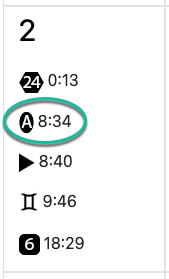
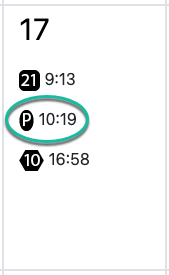
The Lunar Nodes
The Lunar Nodes are the points of the Moon's orbit where the Moon crosses the ecliptic (the path of the Sun around the sky). These are considered as important in the European tradition as the days when the Moon passes over one of her nodes are believed to be unfavourable for cultivating the soil, sowing and harvesting.
Maria Thun wrote about this in Work on the Land and the Constellations:
...When sowings are made with only one of the planets or the Moon at the node, it is likely that future growth will be adversely affected. It appears that the effect which these intersections or nodes have would make it advisable to avoid these particular times when working with plants.
You can see from this passage that Maria Thun considers not only Lunar Nodes to be of importance but also the planetary nodes, when a planet crosses the ecliptic. However, planetary nodes transits are relatively rare, and currently they are not implemented in the Lunar Gardening Calendar.
This is how Lunar Nodes are shown in the Lunar Gardening Calendar:
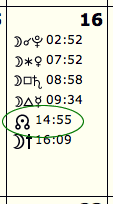
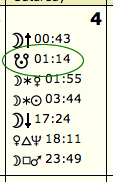
The Eclipses
The eclipses are related to the Lunar Nodes but have a longer lasting and more pronounced effect. They occur when either the New Moon or the Full Moon happens near the Lunar Nodes (within 5 degrees of them). A New Moon then produces a solar eclipse while the Full Moon produces a lunar eclipse.
Eclipses are major disturbances for the Earth's energetic fields and so it is commonly advised to avoid any activities close to them. I find the following passage from Nick Kollerstrom's Gardening and Planting by the Moon very informative:
Early tablets from ancient Babylon testified to the belief in the infertility of the land around the time of an eclipse. As a belief, it has endured longer than most. The early bio-dynamic sowing calendars by Franz Rulni advocated not sowing anything important for several days after an eclipse, while its successor, the modern Thun calendar, gives just the day of an eclipse as not good for planting.
In the Netherlands, there is a garden with a few ragged pear trees which only started to bear small, bitter fruit nine years after they were planted. As a test, they were deliberately planted at the inauspicious moment of a solar eclipse by Karen Hamaker-Zontag, the eminent Dutch astrologer.
This is how eclipses are shown in the Lunar Gardening Calendar:
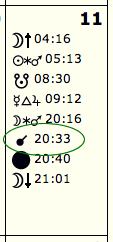
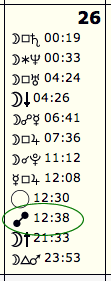
The Planetary Aspects
As the planets move around the sky, they form angular relationships between each other. These angles are called aspects in astrology, and here are the aspects that are used most often, with their symbols:

Of these, Opposition and Square are considered to be difficult, inhibiting, stressful, and so generally "bad". Trine and Sextile are generally "good" as they are harmonious and promote growth. The nature of Conjunction per se is neutral as its effect depends on the nature of the planets making the aspect.
To read the aspects in the Lunar Gardening Calendar, you will also need to know the symbols of the planets, and here they are:

Now, let's read a few planetary aspects in the calendar. Here is how they look:
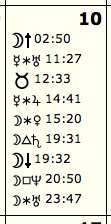
The Lunar Gardening Calendar lists all the aspects that take place, but they have different value for gardening and it is up to you to decide which aspects you prefer to use, which of them you consider as the most important. I can only offer you the opinions of a couple of authors.
Nick Kollerstrom has a chapter titled Gardening Aspects. Here are some highlights from it:
- Moon – Saturn aspects have particular importance to agriculture and the life of plants.
- Some Moon – Sun aspects are important.
- Moon – Venus aspects are recommended for working with flowers.
- The Moon's sextile to Saturn "it is then commended to labour the earth, sow, and plant" (quoted by Nick Kollerstrom from The Gardener's Labyrinth, a work by Thomas Hill published in 1577). Moon trine Saturn is a similarly beneficial aspect.
- The Moon's square to Saturn is when it is "denied utterly to deal in such matters" (The Gardener's Labyrinth). The Moon – Saturn opposition is similarly negative.
- For planting crops, the general advice is: plant when the Moon is in conjunction, sextile or trine with Saturn.
- Sun – Moon aspects are important for working with vines, and the trine is particularly favourable.
Maria Thun has a substantially different idea about the significance of different aspects. Here are a few highlights from Work on the Land and the Constellations:
- Opposition: a greater intensification of the life processes of the plant. This begins a few days before and increases up to the point of the opposition. The forces of both planets interpenetrate, augment and intensify each other.
- Conjunction: the planets do not mutually enhance each other's influences, but rather cancel out.
Ascending and Descending Moon
This is a factor that is quite often used in lunar gardening calendars and is considered to be important. However, its name is rather misleading. It has nothing to do with moonrise and moonset, as well as waxing and waning Moon.
These factors are not depicted in any way in the Lunar Gardening Calendar. In fact, the easiest and the most precise way to know when the Moon is Ascending and when it is Descending is to use the Universal Lunar Calendar, as the tropical zodiac is more appropriate in this case.
The Moon is ascending when it is situated in the zodiac in the second half of Capricorn, Aquarius, Pisces, Aries, Taurus, Gemini or the first half of Cancer. According to Michel Gros, this is when plants contain more sap, so there is more activity in the aerial parts (those above the ground).
This is a good time, for example, to cut scions, to graft plants and to harvest fruit with a high juice content, as well as to collect sap from silver birches, etc. However, it is better to avoid pruning trees or cutting plants for drying at this time. Cutting lawns when the Moon is ascending tends to encourage plenty of growth; it is a good time to aerate them.
The Moon is descending when it is situated in the second half of Cancer, Leo, Virgo, Libra, Scorpio, Sagittarius or the first half of Capricorn. As Michel Gros writes,
When the Moon is descending, the flow of fluids in plants descends also and growth occurs mainly in the roots. This is a good time to harvest root crops or the aerial parts of a plant that you want to dry quickly, and also for pruning, pricking out, re-potting, ploughing, spreading compost or manure and cutting wood. The grass of lawns that are cut at this time forms stronger roots and anchors the soil better.
Lunar Gardening Books
Llewellyn's Moon Sign Book
This book is published every year. I've got its 1997 and 2009 versions, both have lunar gardening instructions in them, so I believe the future versions are going to have them as well.
Additionally, the book contains a lot of useful, or at least curious information, like best days for various activities, weather and economic forecasts, New and Full Moon forecasts, and a lot more.
Michel Gros, In Tune With The Moon
I like this little book because it is colourful, well crafted, contains succinct information for many aspects of the Lunar Lore, not only Lunar Gardening. A little bit on animal husbandry, beer and cider making, beekeeping, cutting nails and many other subjects.
There is also a colourful, easy to use Lunar Gardening Calendar, new in every edition of the book.
Nick Kollerstrom, Gardening And Planting By The Moon
The author is a researcher, well known in the British Astrology, and his book (published yearly, as it contains a lunar gardening calendar) is full of facts and diagrams that should convince even the most stubborn non-believers that the rules of the Lunar Gardening do work quite well.
There is also an advice for each month, what to do in the garden.
Maria Thun, Matthias Thun, The Biodynamic Sowing And Planting Calendar
This is a yearly publication by a recognized authority in Lunar Gardening. Contains a detailed calendar and a substantial amount of informative reading, including sections like Antroposophical insights into honey and Recipe for rye bread.
Maria Thun, Work On The Land And The Constellations
This book isn't easy to find as it is out of print but I was able to find it through Amazon.
It is clearly worth the effort as it contains a wealth of information, and not only on Biodynamic Gardening and its astronomical/astrological background but also on weather observations, experiments showing the influence of constellations on bees, and homeopathic methods of regulating pests.